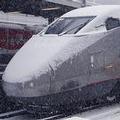 美國總統歐巴馬16日發佈一項新的高速鐵路系統計劃。他說此計劃將減少美國民眾對汽車和飛機依賴,並能促進經濟發展。
美國總統歐巴馬16日發佈一項新的高速鐵路系統計劃。他說此計劃將減少美國民眾對汽車和飛機依賴,並能促進經濟發展。
該計劃擬自「經濟復甦法案」撥出80億美元,再加上連續5年每年10億美元的聯邦預算,用以立即推動世界級客運鐵路系統,並設定歐巴馬交通政策的大方向。
「我們現在所談的是美國高速鐵路網願景。想像我們從市中心搭上火車,不急不徐前往機場或橫越登機大厦、不會誤點、不用坐在停機坪上,沒有行李遺失,更不用脫鞋。(眾笑)。想像以超過100英里的時速在城鎮間迅速移動,卻只需走幾步路到車站,下車後走過幾個街區後就抵達目的地。試想這將是一個重建美國的偉大計劃。 」總統在華盛頓舉行的記者會上說道。
「這不是空中閣樓,也不是烏托邦式的夢想。正是現在,在此發生。這已發展了幾十年。問題在於它在其他地方發展,而不是美國。」歐巴馬說。他所提及的高速鐵路發展是在法國、西班牙、中國,和日本。
該計劃確認兩種類型的工程計畫得以申請補助。一種會創造出提供世界一流高鐵服務的交通走廊。另一種將使現有路線的鐵路服務更快速。
歐巴馬計劃確定10個高速鐵路走廊為聯邦補助的潛在受益者:加利福尼亞州,太平洋西北區,中南區,墨西哥灣沿岸地區,芝加哥樞紐網絡,佛羅里達州,東南區,帝國區,新英格蘭北部的基石走廊,和賓夕法尼亞州。
爭取補助的機會也存在於自華盛頓到波士頓的東北走廊,用以改善美國現有唯一的高速鐵路。各州和當地社區正受邀將100英里鐵路網擴充成600英里的鐵路走廊,這計劃將可爭取聯邦補助。
聯邦政府替各州和地方的補助申請出版了詳細的指導手冊。在今年夏季末,聯邦鐵路管理局將開始頒發第一輪款項補助,開始把此一理想化為實際行動。
「如同《經濟復甦法案》的補助,這筆錢將在價值基礎上分派。這不是政治,也不是主張,更不是為任何其他考慮,純粹基於價值。」歐巴馬說。
根據此一計劃,高速鐵路的發展將透過三種資金管道:
- 個別工程計畫。提供補助以完成個別完備的工程計劃,這將包括完整的環境和初期工程,重點在於創造短期就業機會。合格的計畫項目包括購置、建造,或改進基礎設施,周邊設施和設備。
- 走廊計劃。開發整個階段或已完成規劃的地區高速鐵路走廊。包含完整走廊計畫、環保文件,和優先次序的項目清單,以達成走廊計畫目標。
- 計劃。進入計劃的合作協議階段,包括走廊計劃的開發和國家鐵路計劃,使用非美國籍復甦與再投資法案的撥款資金。這個方式的目的是幫助建立一個結構式的機制和資金流向以利日後的走廊開發活動。
「一個主要的嶄新的高速鐵路將在未來幾年創造成千上萬的建設工作,以及鐵路服務員工等永久性工作,並增進各站區的經濟活動。高速鐵路計畫早該進行,它更讓美國旅客了解,他們並非注定在機場大排長龍或在高速公路的車陣中動彈不得。」總統說。
「身為35年鐵路通勤者,這項宣布深得我心。投資高速鐵路系統將降低我們對外國石油與天然氣的依賴;減輕壅塞的令人窒息的空陸交通;並明顯地減少我們對地球造成的傷害。」副總統拜登說。
「歐巴馬總統的願景很真實,高速鐵路提供了美國人旅行的新選擇,這類選擇歷史上均有助於經濟成長和提高生活品質。我們不可能將未來的經濟發展建設在過去的交通網絡上。」秘書拉胡德說(Ray LaHood)。
President Barack Obama Thursday released his administration's plan for a new high-speed rail system that he says will reduce dependence on cars and planes and spur economic development.
The plan identifies $8 billion provided in the Recovery Act plus $1 billion a year for five years requested in the federal budget to jumpstart a world-class passenger rail system and set the direction of the Obama transportation policy.
"What we're talking about is a vision for high-speed rail in America," said the President at a news conference in Washington. "Imagine boarding a train in the center of a city. No racing to an airport and across a terminal, no delays, no sitting on the tarmac, no lost luggage, no taking off your shoes. (Laughter.) Imagine whisking through towns at speeds over 100 miles an hour, walking only a few steps to public transportation, and ending up just blocks from your destination. Imagine what a great project that would be to rebuild America."
"This is not some fanciful, pie-in-the-sky vision of the future," said Obama. "It is now. It is happening right now. It's been happening for decades. The problem is it's been happening elsewhere, not here," he said, mentioning high-speed rail developments in France, Spain, China and Japan.
The plan identifies two types of projects for funding. One would create new corridors for world-class high-speed rail. The other would involve making train service along existing rail lines faster.
The Obama plan identifies 10 high-speed rail corridors as potential recipients of federal funding: California, Pacific Northwest, South Central, Gulf Coast, Chicago Hub Network, Florida, Southeast, Empire, Northern New England and the Keystone Corridor in Pennsylvania.
Opportunities also exist for the Northeast Corridor from Washington to Boston to compete for funds to improve the nation only existing high-speed rail service.
States and local communities are invited to put together plans for a network of 100 mile to 600 mile corridors, which will compete for the federal dollars.
The government is publishing a detailed guidance for state and local applicants for the funds, and by late summer, the Federal Railroad Administration will begin awarding the first round of grants to fund projects that will begin to turn this vision into reality.
"Like all funding decisions under the Recovery Act, money will be distributed based on merit," said Obama, "not on politics, not as favors, not for any other consideration - purely on merit."
Under the plan, high-speed rail development will advance along three funding tracks:
- Individual Projects. Providing grants to complete individual projects that are "ready to go?with completed environmental and preliminary engineering work ?with an emphasis on near term job creation. Eligible projects include acquisition, construction of or improvements to infrastructure, facilities and equipment.
- Corridor programs. Developing entire phases or geographic sections of high-speed rail corridors that have completed corridor plans, environmental documentation and have a prioritized list of projects to help meet the corridor objectives.
- Planning. Entering into cooperative agreements for planning activities, including development of corridor plans and State Rail Plans, using non-American Recovery and Reinvestment Act appropriations funds. This third approach is intended to help establish a structured mechanism and funding stream for future corridor development activities.
"A major new high-speed rail line will generate many thousands of construction jobs over several years, as well as permanent jobs for rail employees and increased economic activity in the destinations these trains serve," said the President. "High-speed rail is long-overdue, and this plan lets American travelers know that they are not doomed to a future of long lines at the airports or jammed cars on the highways.?
"As a daily rail commuter for over 35 years, this announcement is near and dear to my heart," said Vice President Joe Biden. "Investing in a high-speed rail system will lower our dependence on foreign oil and the bill for a tank of gas; loosen the congestion suffocating our highways and skyways; and significantly reduce the damage we do to our planet?
"President Obama's vision of robust, high-speed rail service offers Americans the kind of travel options that throughout our history have contributed to economic growth and enhanced quality of life,?said Secretary Ray LaHood. "We simply can't build the economy of the future on the transportation networks of the past?

